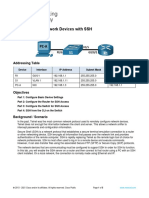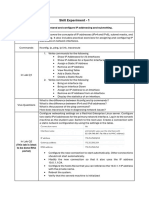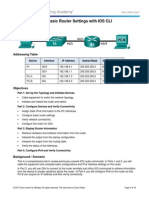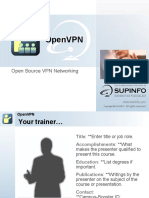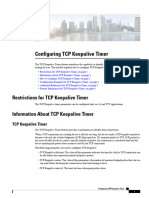m_controller-self-signed-certificate
m_controller-self-signed-certificate
Uploaded by
library.books.2023Copyright:
Available Formats
m_controller-self-signed-certificate
m_controller-self-signed-certificate
Uploaded by
library.books.2023Copyright
Available Formats
Share this document
Did you find this document useful?
Is this content inappropriate?
Copyright:
Available Formats
m_controller-self-signed-certificate
m_controller-self-signed-certificate
Uploaded by
library.books.2023Copyright:
Available Formats
Controller Self-Signed Certificate for Wireless
AP Join
• Use Cases, on page 1
• Prerequisites, on page 2
• Configuring Clock Calendar (CLI), on page 2
• Enabling HTTP Server (CLI), on page 3
• Configuring CA Server (CLI), on page 3
• Configuring Trustpoint (CLI), on page 5
• Authenticating and Enrolling the PKI TrustPoint with CA Server (CLI), on page 6
• Tagging Wireless Management TrustPoint Name (CLI), on page 7
• Verifying Controller Certificates for Wireless AP Join, on page 7
Use Cases
Use Case-1
Cisco Catalyst 9800-CL platform does not contain manufacturer installed SUDI certificates. You will need
to configure Self-Signed Certificates on your controller.
Use Case-2
APs running on earlier versions and having Manufacturer Installed Certificate (MIC) issued by a SHA1 Cisco
Trusted CA cannot join the controller with SHA2 SUDI certificate. During CAPWAP join process, the AP
displays a bad certificate error and tears down the DTLS handshake.
Workaround: To upgrade APs, configure controller Self-Signed certificates. Once done, you can delete the
Self-Signed certificates and revert back to the SUDI certificate.
Note This workaround does not apply to the Embedded Wireless Controller running Catalyst 9k switches. But
applies to other hardware appliance controllers, such as Cisco Catalyst 9800-40, Cisco Catalyst 9800-80, and
Cisco Catalyst 9800-L.
Controller Self-Signed Certificate for Wireless AP Join
1
Controller Self-Signed Certificate for Wireless AP Join
Prerequisites
Note Certificate used in DTLS connections (AP and mobility) must use RSA key of size equal or more than 2048
bits. Otherwise, the APs and mobility connections will fail after reload. Run the show crypto pki certificate
verbose _tp-name_ command to display the key size of the device certificate.
Prerequisites
• Ensure that the VLAN interface is up and it’s IP is reachable.
• Ensure that the ip http server is enabled. For more information, see Enabling HTTP Server.
• Set the clock calendar-valid command appropriately. For more information, see #unique_1246.
• Check if the PKI CA server is already configured or not. If configured, you will need to delete the existing
CA server configuration.
Note The show crypto pki server command output should not display anything.
Configuring Clock Calendar (CLI)
Procedure
Command or Action Purpose
Step 1 configure terminal Enters global configuration mode.
Example:
Device# configure terminal
Step 2 clock calendar-valid Enables clock calendar.
Example:
Device(config)# clock calendar-valid
Step 3 exit Exits configuration mode.
Example:
Device(config)# exit
Controller Self-Signed Certificate for Wireless AP Join
2
Controller Self-Signed Certificate for Wireless AP Join
Enabling HTTP Server (CLI)
Enabling HTTP Server (CLI)
Procedure
Command or Action Purpose
Step 1 configure terminal Enters global configuration mode.
Example:
Device# configure terminal
Step 2 ip http server Enables the HTTP server on your IP or IPv6
system, including a Cisco web browser user
Example:
interface. By default, the HTTP server uses the
Device(config)# ip http server standard port 80.
Step 3 ip http secure-server Enables the HTTP server on your IP or IPv6
system, including a Cisco web browser user
Example:
interface. By default, the HTTP server uses the
Device(config)# ip http secure-server standard port 80.
Step 4 exit Exits configuration mode.
Example:
Device(config)# exit
Configuring CA Server (CLI)
Procedure
Command or Action Purpose
Step 1 configure terminal Enters global configuration mode.
Example:
Device# configure terminal
Step 2 crypto key generate rsa general-keys Configures a certificate for the controller.
modulus size_of_key_module label
When you generate RSA keys, you are
keypair_name
prompted to enter a modulus length. A longer
Example: modulus length might be more secure, but it
Device(config)# crypto key generate rsa takes longer to generate and to use.
general-keys modulus 2048 label WLC_CA
Note
The recommended key-pair name is WLC_CA
and key modulus is 2048 bits.
Step 3 crypto pki server certificate_server_name Enables IOS certificate server.
Controller Self-Signed Certificate for Wireless AP Join
3
Controller Self-Signed Certificate for Wireless AP Join
Configuring CA Server (CLI)
Command or Action Purpose
Example: Note
Device(config)# crypto pki server WLC_CA The certificate_server_name must be the same
name as the keypair_name.
Step 4 issuer-name Configures X.509 distinguished name for the
issuer CA certificate.
Example:
Device(config)# issuer-name O=Cisco Note
Virtual Wireless LAN Controller, You need to configure the same issuer-name
CN=CA-vWLC as suggested for AP join.
Step 5 grant auto Grants certificate requests automatically.
Example:
Device(config)# grant auto
Step 6 hash sha256 (Optional) Specifies the hash function for the
signature used in the granted certificates.
Example:
Device(config)# hash sha256
Step 7 lifetime ca-certificate time-interval (Optional) Specifies the lifetime in days of a
CA certificate.
Example:
Device(config)# lifetime ca-certificate
3650
Step 8 lifetime certificate time-interval (Optional) Specifies the lifetime in days of a
granted certificate.
Example:
Device(config)# lifetime certificate
3650
Step 9 database archive pkcs12 password password Sets the CA key and CA certificate archive
format and password to encrypt the file.
Example:
Device(config)# database archive pkcs12
password 0 cisco123
Step 10 no shutdown Enables the certificate server.
Example: Note
Device(config)# no shutdown Issue this command only after you have
completely configured your certificate server.
Step 11 end Returns to privileged EXEC mode.
Alternatively, you can also press Ctrl-Z to exit
Example:
global configuration mode.
Device(config)# end
Controller Self-Signed Certificate for Wireless AP Join
4
Controller Self-Signed Certificate for Wireless AP Join
Configuring Trustpoint (CLI)
Configuring Trustpoint (CLI)
Procedure
Command or Action Purpose
Step 1 configure terminal Enters global configuration mode.
Example:
Device# configure terminal
Step 2 crypto key generate rsa exportable When you generate RSA keys, you are
general-keys modulus prompted to enter a modulus length. A longer
size-of-the-key-modulus label label modulus length might be more secure, but it
takes longer to generate and to use.
Example:
Device(config)# crypto key generate rsa
exportable general-keys modulus 2048
label ewlc-tp1
Step 3 crypto pki trustpoint trustpoint_name Creates a new trust point for an external CA
server. Here, trustpoint_name refers to the
Example:
trustpoint name.
Device(config)# crypto pki trustpoint
ewlc-tp1 Note
Ensure that same names are used for key-pair
(label) and trustpoint_name.
Step 4 rsakeypair RSA_key key_size Maps RSA key with that of the trustpoint.
Example: • RSA_key—Refers to the RSA key pair
Device(ca-trustpoint)# rsakeypair label.
ewlc-tp1
• key_size—Refers to the signature key
length. The value ranges from 360 to
4096.
Step 5 subject-name subject_name Creates subject name parameters for the
trustpoint.
Example:
Device(ca-trustpoint)# subject-name
O=Cisco Virtual Wireless LAN Controller,
CN=DEVICE-vWLC
Step 6 revocation-check none Checks revocation.
Example:
Device(ca-trustpoint)# revocation-check
none
Step 7 hash sha256 Specifies the hash algorithm.
Example:
Controller Self-Signed Certificate for Wireless AP Join
5
Controller Self-Signed Certificate for Wireless AP Join
Authenticating and Enrolling the PKI TrustPoint with CA Server (CLI)
Command or Action Purpose
Device(ca-trustpoint)# hash sha256
Step 8 serial-number Specifies the serial number.
Example:
Device(ca-trustpoint)# serial-number
Step 9 eku request server-auth client-auth (Optional) Sets certificate key-usage purpose.
Example:
Device(ca-trustpoint)# eku request
server-auth client-auth
Step 10 password password Enables password.
Example:
Device(config)# password 0 cisco123
Step 11 enrollment url url Enrolls the URL.
Example: Note
Device(config)# enrollment url Replace the dummy IP with management
http://<management-IPv4>:80 VLAN interface IP of the controller where
CA server is configured.
Step 12 exit Exits the configuration.
Example:
Device(config)# exit
Authenticating and Enrolling the PKI TrustPoint with CA Server
(CLI)
Procedure
Command or Action Purpose
Step 1 configure terminal Enters global configuration mode.
Example:
Device# configure terminal
Step 2 crypto pki authenticate trustpoint_name Fetches the CA certificate.
Example:
Device(config)# crypto pki authenticate
ewlc-tp1
Certificate has the following attributes:
Fingerprint MD5: 64C5FC9A C581D827
C25FC3CF 1A7F42AC
Fingerprint SHA1: 6FAFF812 7C552783
Controller Self-Signed Certificate for Wireless AP Join
6
Controller Self-Signed Certificate for Wireless AP Join
Tagging Wireless Management TrustPoint Name (CLI)
Command or Action Purpose
6A8FB566 52D95849 CC2FC050
% Do you accept this certificate?
[yes/no]: yes
Trustpoint CA certificate accepted.
Step 3 crypto pki enroll trustpoint_name Enrolls for client certificate.
Example:
Device(config)# crypto pki enroll
ewlc-tp1
Enter following answers for UI
interaction:
% Include an IP address in the subject
name? [no]: no
Request certificate from CA? [yes/no]:
yes
Step 4 end Returns to privileged EXEC mode.
Alternatively, you can also press Ctrl-Z to exit
Example:
global configuration mode.
Device(config)# end
Tagging Wireless Management TrustPoint Name (CLI)
Procedure
Command or Action Purpose
Step 1 configure terminal Enters global configuration mode.
Example:
Device# configure terminal
Step 2 wireless management trustpoint Tags the wireless management trustpoint name.
trustpoint_name
Example:
Device(config)# wireless management
trustpoint ewlc-tp1
Step 3 end Returns to privileged EXEC mode.
Alternatively, you can also press Ctrl-Z to exit
Example:
global configuration mode.
Device(config)# end
Verifying Controller Certificates for Wireless AP Join
To view the CA server details, use the following command:
Controller Self-Signed Certificate for Wireless AP Join
7
Controller Self-Signed Certificate for Wireless AP Join
Verifying Controller Certificates for Wireless AP Join
Device# show crypto pki server
Certificate Server WLC_CA:
Status: enabled
State: enabled
Server's configuration is locked (enter "shut" to unlock it)
Issuer name: O=Cisco Virtual Wireless LAN Controller, CN=CA-vWLC
CA cert fingerprint: 79A3DBD5 59A7E384 73ABD152 C133F4E2
Granting mode is: auto
Last certificate issued serial number (hex): 1
CA certificate expiration timer: 12:04:00 UTC Mar 8 2029
CRL NextUpdate timer: 18:04:00 UTC Mar 11 2019
Current primary storage dir: nvram:
Database Level: Minimum - no cert data written to storage
To view the trustpoint details, use the following command:
Device# show crypto pki trustpoint ewlc-tp1 status
Trustpoint ewlc-tp1:
...
State:
Keys generated ............. Yes (General Purpose, exportable)
Issuing CA authenticated ....... Yes
Certificate request(s) ..... Yes
To view the wireless management trustpoint details, use the following command:
Device# do show wireless management trustpoint
Trustpoint Name : ewlc-tp1
Certificate Info : Available
Certificate Type : SSC
Certificate Hash : 4a5d777c5b2071c17faef376febc08398702184e
Private key Info : Available
FIPS suitability : Not Applicable
To view the HTTP server status, use the following command:
Device# show ip http server status | include server status
HTTP server status: Enabled
HTTP secure server status: Enabled
Controller Self-Signed Certificate for Wireless AP Join
8
You might also like
- FortiNAC v9.2 Getting Started Guide Partner100% (1)FortiNAC v9.2 Getting Started Guide Partner211 pages
- 16.4.7 Lab - Configure Network Devices With SSH - ILM100% (1)16.4.7 Lab - Configure Network Devices With SSH - ILM11 pages
- How To Configure Cisco Switch in 11 Steps - ManageEngine Network Configuration ManagerNo ratings yetHow To Configure Cisco Switch in 11 Steps - ManageEngine Network Configuration Manager4 pages
- How To Config Local Authentication AuthorizationNo ratings yetHow To Config Local Authentication Authorization4 pages
- Lab 5.2 Securing A Router With Cisco Autosecure: Learning ObjectivesNo ratings yetLab 5.2 Securing A Router With Cisco Autosecure: Learning Objectives8 pages
- 4.4.9 Lab - Configure Network Devices With SSH - ILMNo ratings yet4.4.9 Lab - Configure Network Devices With SSH - ILM10 pages
- HPE - c05321602 - ArubaOS 6.2 - Quick Start GuideNo ratings yetHPE - c05321602 - ArubaOS 6.2 - Quick Start Guide8 pages
- Basic Software Configuration Using The Cisco IOS Command-Line InterfaceNo ratings yetBasic Software Configuration Using The Cisco IOS Command-Line Interface22 pages
- Pulse Policy Secure VM Setup and Config-1 UpdateNo ratings yetPulse Policy Secure VM Setup and Config-1 Update25 pages
- Very Pwnable Networks - HackFest Hollywood 2024No ratings yetVery Pwnable Networks - HackFest Hollywood 202473 pages
- 6.3.1.1 Lab - Securing Layer 2 SwitchesNo ratings yet6.3.1.1 Lab - Securing Layer 2 Switches22 pages
- CCNA Security: Chapter Two Securing Network DevicesNo ratings yetCCNA Security: Chapter Two Securing Network Devices16 pages
- Lab 8.3.1.2 Configure Basic AP Security Through IOS CLI: ObjectiveNo ratings yetLab 8.3.1.2 Configure Basic AP Security Through IOS CLI: Objective10 pages
- Basic Software Configuration Using The Cisco IOS Command-Line InterfaceNo ratings yetBasic Software Configuration Using The Cisco IOS Command-Line Interface22 pages
- Lab 10: Vpns - Ipsec Remote Access VPN: 10.1 DetailsNo ratings yetLab 10: Vpns - Ipsec Remote Access VPN: 10.1 Details24 pages
- Experiment-4: Aim: Connect The Computers in Local Area Network. Procedure: On The Host ComputerNo ratings yetExperiment-4: Aim: Connect The Computers in Local Area Network. Procedure: On The Host Computer19 pages
- Mediant 800 Gateway and e SBC Users Manual Ver 72No ratings yetMediant 800 Gateway and e SBC Users Manual Ver 721,950 pages
- 4.2.3.3 Packet Tracer - Securing Cloud Services in The IoTNo ratings yet4.2.3.3 Packet Tracer - Securing Cloud Services in The IoT4 pages
- 6.3.1.1 Lab - Securing Layer 2 SwitchesNo ratings yet6.3.1.1 Lab - Securing Layer 2 Switches18 pages
- Check Point and ISE Intergration White PaperNo ratings yetCheck Point and ISE Intergration White Paper37 pages
- Mediant 800 Gateway e SBC Users Manual Ver 74No ratings yetMediant 800 Gateway e SBC Users Manual Ver 742,022 pages
- Basic Two Zone Cisco Gateway To Gatekeeper Configuration.................................................................... 1No ratings yetBasic Two Zone Cisco Gateway To Gatekeeper Configuration.................................................................... 132 pages
- Mastering Go Network Automation: Automating Networks, Container Orchestration, Kubernetes with Puppet, Vegeta and Apache JMeterFrom EverandMastering Go Network Automation: Automating Networks, Container Orchestration, Kubernetes with Puppet, Vegeta and Apache JMeterNo ratings yet
- 11.2.4.6 Lab - Accessing Network Devices With SSH - ILMNo ratings yet11.2.4.6 Lab - Accessing Network Devices With SSH - ILM11 pages
- Cisco S390 Web Security Appliance Quick Start GuideNo ratings yetCisco S390 Web Security Appliance Quick Start Guide22 pages
- Lab 2.3.5 Configure General Router Security: ObjectiveNo ratings yetLab 2.3.5 Configure General Router Security: Objective10 pages
- Extreme Management Center®: Cisco Switch Integration GuideNo ratings yetExtreme Management Center®: Cisco Switch Integration Guide26 pages
- Network with Practical Labs Configuration: Step by Step configuration of Router and Switch configurationFrom EverandNetwork with Practical Labs Configuration: Step by Step configuration of Router and Switch configurationNo ratings yet
- MDCAT Practice Test Torque and EquilibriumNo ratings yetMDCAT Practice Test Torque and Equilibrium4 pages
- Hydraulic Cylinder: Single and Double-ActingNo ratings yetHydraulic Cylinder: Single and Double-Acting20 pages
- Immediate download Chemistry 12th Edition Chang Solutions Manual all chapters100% (16)Immediate download Chemistry 12th Edition Chang Solutions Manual all chapters42 pages
- Amie Syllabus System Analysis & Design: Group ANo ratings yetAmie Syllabus System Analysis & Design: Group A1 page
- Relationships Between Liquid Limit, Cation Exchange Capacity, and Swelling Potentials of Clayey SoilsNo ratings yetRelationships Between Liquid Limit, Cation Exchange Capacity, and Swelling Potentials of Clayey Soils8 pages
- Applications of Improved Grey Prediction ModelNo ratings yetApplications of Improved Grey Prediction Model9 pages
- GeoGuide 3 Rock and Soil Descriptions Hong KongNo ratings yetGeoGuide 3 Rock and Soil Descriptions Hong Kong187 pages
- 3it02: Information Security CREDITS - 4 (LTP: 3,0,2)No ratings yet3it02: Information Security CREDITS - 4 (LTP: 3,0,2)2 pages
- Topic 5 Arithmetic & Logic Instruction (ISMAIL - FKEUTM 2018)No ratings yetTopic 5 Arithmetic & Logic Instruction (ISMAIL - FKEUTM 2018)54 pages
- Arts 3: Teacher Kristine Mae Agustin (Author)No ratings yetArts 3: Teacher Kristine Mae Agustin (Author)22 pages
- The Second Law of Thermodynamics: ClausiusNo ratings yetThe Second Law of Thermodynamics: Clausius1 page
- Chapter 2 - First Order Differential EquationNo ratings yetChapter 2 - First Order Differential Equation198 pages
- 16.4.7 Lab - Configure Network Devices With SSH - ILM16.4.7 Lab - Configure Network Devices With SSH - ILM
- How To Configure Cisco Switch in 11 Steps - ManageEngine Network Configuration ManagerHow To Configure Cisco Switch in 11 Steps - ManageEngine Network Configuration Manager
- Lab 5.2 Securing A Router With Cisco Autosecure: Learning ObjectivesLab 5.2 Securing A Router With Cisco Autosecure: Learning Objectives
- 4.4.9 Lab - Configure Network Devices With SSH - ILM4.4.9 Lab - Configure Network Devices With SSH - ILM
- Basic Software Configuration Using The Cisco IOS Command-Line InterfaceBasic Software Configuration Using The Cisco IOS Command-Line Interface
- CCNA Security: Chapter Two Securing Network DevicesCCNA Security: Chapter Two Securing Network Devices
- Lab 8.3.1.2 Configure Basic AP Security Through IOS CLI: ObjectiveLab 8.3.1.2 Configure Basic AP Security Through IOS CLI: Objective
- Basic Software Configuration Using The Cisco IOS Command-Line InterfaceBasic Software Configuration Using The Cisco IOS Command-Line Interface
- Lab 10: Vpns - Ipsec Remote Access VPN: 10.1 DetailsLab 10: Vpns - Ipsec Remote Access VPN: 10.1 Details
- Experiment-4: Aim: Connect The Computers in Local Area Network. Procedure: On The Host ComputerExperiment-4: Aim: Connect The Computers in Local Area Network. Procedure: On The Host Computer
- 4.2.3.3 Packet Tracer - Securing Cloud Services in The IoT4.2.3.3 Packet Tracer - Securing Cloud Services in The IoT
- Basic Two Zone Cisco Gateway To Gatekeeper Configuration.................................................................... 1Basic Two Zone Cisco Gateway To Gatekeeper Configuration.................................................................... 1
- Mastering Go Network Automation: Automating Networks, Container Orchestration, Kubernetes with Puppet, Vegeta and Apache JMeterFrom EverandMastering Go Network Automation: Automating Networks, Container Orchestration, Kubernetes with Puppet, Vegeta and Apache JMeter
- 11.2.4.6 Lab - Accessing Network Devices With SSH - ILM11.2.4.6 Lab - Accessing Network Devices With SSH - ILM
- Cisco S390 Web Security Appliance Quick Start GuideCisco S390 Web Security Appliance Quick Start Guide
- Lab 2.3.5 Configure General Router Security: ObjectiveLab 2.3.5 Configure General Router Security: Objective
- Extreme Management Center®: Cisco Switch Integration GuideExtreme Management Center®: Cisco Switch Integration Guide
- Network with Practical Labs Configuration: Step by Step configuration of Router and Switch configurationFrom EverandNetwork with Practical Labs Configuration: Step by Step configuration of Router and Switch configuration
- Immediate download Chemistry 12th Edition Chang Solutions Manual all chaptersImmediate download Chemistry 12th Edition Chang Solutions Manual all chapters
- Relationships Between Liquid Limit, Cation Exchange Capacity, and Swelling Potentials of Clayey SoilsRelationships Between Liquid Limit, Cation Exchange Capacity, and Swelling Potentials of Clayey Soils
- 3it02: Information Security CREDITS - 4 (LTP: 3,0,2)3it02: Information Security CREDITS - 4 (LTP: 3,0,2)
- Topic 5 Arithmetic & Logic Instruction (ISMAIL - FKEUTM 2018)Topic 5 Arithmetic & Logic Instruction (ISMAIL - FKEUTM 2018)




















